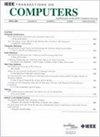EC2P:通过hub抵抗Abort攻击的高性价比跨链支付
IF 3.8
2区 计算机科学
Q2 COMPUTER SCIENCE, HARDWARE & ARCHITECTURE
引用次数: 0
摘要
跨链技术促进了孤立区块链之间的互操作性,用户可以在其中转移和交换硬币。虽然像以太坊这样的图灵完备(TC)区块链和像比特币这样的非图灵完备(NTC)区块链之间的异质性对跨链交易提出了重大挑战。支付通道中心(PCHs)为实现TC-NTC跨链支付提供了一个有希望的解决方案,具有高吞吐量和低确认延迟。然而,现有方案仍然面临两个关键挑战:(i)可变金额支付的巨大计算和通信开销,以及(ii)有限的不可链接性,即容易受到中止攻击。EC2P是第一个实现可变金额支付不可链接性的TC-NTC跨链PCH,同时抵抗中断攻击并最大限度地减少对非交互式零知识(NIZK)证明的依赖。EC2P引入了两种协议:NTC-to-TC和TC-to-NTC支付协议。NTC-to-TC支付协议用半盲方法取代了传统的谜题-承诺和谜题-解决模式,其中只有一方被蒙蔽,而被蒙蔽的一方的互动被消除。在没有NIZK的情况下,这实现了不可链接性和抵抗中止攻击。tc到ntc支付协议通过利用图灵完备功能来约束无法执行中止攻击,从而增强了范式。通过严格的安全性分析,我们证明了EC2P在抵御中止攻击的同时具有安全性和可变金额支付不可链接性。我们在以太坊和比特币测试网络上实现了EC2P。我们的评估表明,EC2P在通信和计算开销方面都优于现有的可变量方法,并将通信成本降低了3个数量级。本文章由计算机程序翻译,如有差异,请以英文原文为准。
EC2P: Cost-Effective Cross-Chain Payments via Hubs Resisting the Abort Attack
Cross-chain technology facilitates the interoperability among isolated blockchains, where users can transfer and exchange coins. While the heterogeneity between Turing-complete (TC) blockchains like Ethereum and non-Turing-complete (NTC) blockchains like Bitcoin presents a significant challenge for cross-chain transactions. Payment Channel Hubs (PCHs) offer a promising solution for enabling TC-NTC cross-chain payments with high throughput and low confirmation delays. However, existing schemes still face two key challenges: (i) significant computation and communication overhead for variable-amount payment, and (ii) limited unlinkability, i.e., vulnerable to the abort attack. This paper proposes EC2P, the first TC-NTC cross-chain PCH that achieves variable-amount payment unlinkability while resisting the abort attack and minimizing reliance on non-interactive zero-knowledge (NIZK) proofs. EC2P introduces two protocols: the NTC-to-TC and TC-to-NTC payment protocols. The NTC-to-TC payment protocol replaces the traditional puzzle-promise and puzzle-solve paradigm with a semi-blind approach, where only one side is blinded and the blinded side’s interactions are eliminated. This achieves unlinkability and resists the abort attack without NIZK. The TC-to-NTC payment protocol enhances the paradigm by utilizing Turing-complete functionality to constrain the inability to carry out an abort attack. Through rigorous security analysis, we show that EC2P is secure and variable-amount payment unlinkable while resisting the abort attack. We implement EC2P on Ethereum and Bitcoin test networks. Our evaluation demonstrates that EC2P outperforms both in terms of communication and computation overhead and reduces communication costs by 3 orders of magnitude compared to existing variable-amount methods.
求助全文
通过发布文献求助,成功后即可免费获取论文全文。
去求助
来源期刊

IEEE Transactions on Computers
工程技术-工程:电子与电气
CiteScore
6.60
自引率
5.40%
发文量
199
审稿时长
6.0 months
期刊介绍:
The IEEE Transactions on Computers is a monthly publication with a wide distribution to researchers, developers, technical managers, and educators in the computer field. It publishes papers on research in areas of current interest to the readers. These areas include, but are not limited to, the following: a) computer organizations and architectures; b) operating systems, software systems, and communication protocols; c) real-time systems and embedded systems; d) digital devices, computer components, and interconnection networks; e) specification, design, prototyping, and testing methods and tools; f) performance, fault tolerance, reliability, security, and testability; g) case studies and experimental and theoretical evaluations; and h) new and important applications and trends.
 求助内容:
求助内容: 应助结果提醒方式:
应助结果提醒方式:


